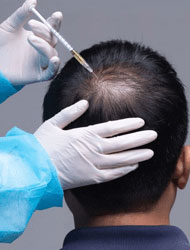What Is PRP (Platelet-rich Plasma) For Hair Loss Treatment?
PRP (platelet-rich plasma) treatment for going bald is a three-step medical treatment in which an individual's blood is drawn, processed, and afterward infused into the scalp. Specialists regularly utilize this treatment when balding outcomes from androgenetic alopecia, a typical condition that makes hair follicles shrivel. In guys, this is called male pattern baldness.
PRP treatment is a three-step procedure. Most PRP treatment requires three procedures 4-6 weeks apart.
stage 1
Your blood is drawn — commonly from your arm — and put into a rotator (a machine that turns quickly to isolate liquids of various densities).
stage 2
After around 10 minutes in the rotator, your blood will have isolated into three layers:
- platelet-poor plasma
- platelet-rich plasma
- red blood cells

Stage 3 The platelet-rich plasma is drawn up into a needle and afterward infused into territories of the scalp that need expanded hair development.
PRP isn't a solution for conditions that cause going bald. Thus, an individual would need to get different medicines over the long run to keep up hair development results. The equivalent is valid for meds that specialists regularly use to treat androgenetic alopecia, for example, effective minoxidil (Regaine) and oral finasteride (Propecia).
The specialist's proposals for how frequently an individual ought to have prp will fluctuate contingent upon an individual's condition and the consequences of their underlying treatment. The hair doctor in vijayawada may recommend having upkeep infusions each 3–6 months once balding is leveled out.
PRP for balding and the scalp is viewed as exceptionally safe:
- PRP treatment is immunologically unbiased and has no peril of sensitivities, allergies, or unfamiliar body responses.
- it's a sterile strategy that must be utilized at each phase of planning and application. PRP is very valuable on the off chance that a patient has a hidden ailment that makes the person in question inclined to disease.
- PRP has an extremely brief time of aggravation at the locales of wounds hence diminishing any conceivable infection.
Now and again, it might be uncomfortable and difficult so effective sedative or cooling shower is regularly utilized. There is basically no down time following a system and you ought to have the option to have returned to work the following day will no recognizable hint of the infusions.
It has some conceivable side effects from infusions and from the methodology itself, including:
- blood vessel injury on the scalp
- nerve injury
- infection at the infusion site
- calcification or scar tissue where the infusions are finished
- side impacts from sedation utilized during the system, for example, muscle hurts, disarray, or bladder control issues
Get the hair fall treatment from the best hair specialist in vijayawada Dr. Udaya Sarvani Poranki.
